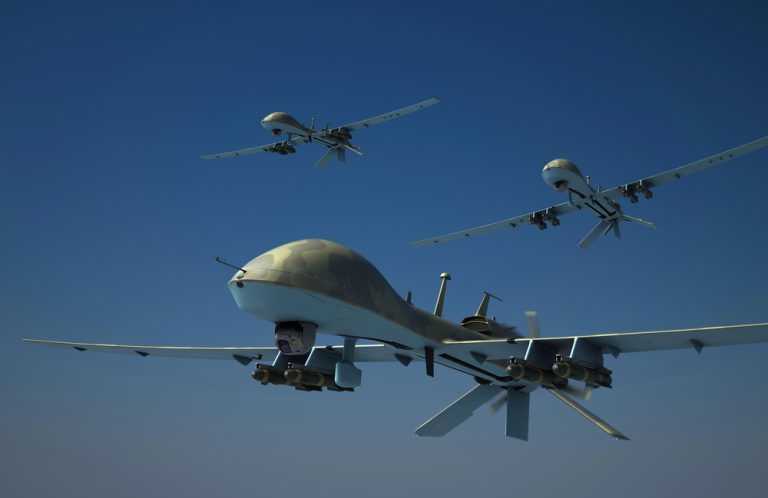As revealed in the Global Peace Index 2025 (GPI)Technological innovation, in particular in the drone war and artificial intelligence, makes conflicts more accessible and more asymmetrical – but with this, also more difficult to solve.
In just two years, the number of manufacturing drones companies has exploded from six in 2022 to more than 200 by 2024. In Ukraine only, more than 2.5 million drones should be produced in 2025. The battlefield is transformed into a test report for this new war mode, with drone attacks by Ukrainian forces.
The next generation of drones should be improved in AI, capable of autonomous navigation, swarm coordination and precision targeting. These systems not only represent technological upgrades, but a deep change in the way wars are carried out. Drone swarms can now be deployed with limited human supervision, allowing sustained operations, at low cost and high impact on prolonged periods.
One of the most destabilizing aspects of improvised drone and weapons technology is its low cost and high impact. Technologies only costing hundreds of dollars can now deactivate or destroy military assets worth millions. This leveling of the battlefield fundamentally restores the balance of power between state actors and non -state actors, giving insurgents and militia tools which allow them to resist the much more powerful conventional forces.
This dynamic takes place not only in Ukraine, but around the world. The proliferation of drone and IED technology means that small groups of insurgents can now cause conflicts in long attrition campaigns. This emerging trend helps to explain the increase in conflicts which do not have a clear end point – the so -called “wars forever” which challenge the resolution and SAP resources for years, even decades.
The GPI 2025 stresses that the world has now experienced the greatest number of public conflicts since the Second World War – 59 in total – and that 78 countries were involved in conflicts beyond their borders in 2024. This high level of internationalization is aggravated by the ease with which modern conflict technologies can be deployed and exported.
Above all, the GPI 2025 notes that conflicts are not only more frequent but more difficult to finish. The share of conflicts which led to a decisive victory increased from 49% in the 1970s to only 9% in the 2010s. Likewise, those who resolved the peace agreements rose from 23% to only 4%.
While drone technology continues to spread, it is probably adopted by rebel groups, militias and non -state actors through fragile states – especially in regions subject to conflicts such as the Sahel, the Middle East and certain parts of South Asia. Once integrated into local theaters, these technologies make conflicts more complex, less centralized and increasingly difficult for traditional peacekeeping or resolution interventions.
The GPI 2025 reports that the global economic impact of violence reached 19.97 billions of dollars in 2024, which is equivalent to 11.6% of world GDP. Military spending alone reached a record of 2.7 billions of dollars. As military budgets increase in response to the increase in threats, investment in peacebuilding has decreased sharply, peacekeeping and conflict prevention representing only 0.52% of total military spending.
The profitability of asymmetrical technologies such as drones and IED creates an imbalance: low -cost tactics can cause high -cost military responses, stretch national budgets and divert funds from essential public services. As indicated in the GPI, this compromise between defense and social cohesion can exacerbate political polarization and long -term instability, in particular in Western democracies.
Ukraine illustrates the rise of technological conflicts. The country has become the epicenter of innovation in the deployment of drones, both in production and in the application of the battlefield. It has integrated the use of mass drones in conventional military operations, while also adapting inexpensive drones for surveillance, targeting and direct attacks.
The field of GPI militarization shows clear deterioration for Ukraine and Russia, with Ukraine ranking 160th on this measure. Despite these setbacks, Ukraine’s innovation in the face of adversity points out a new decentralized adaptive war era. But the long -term implications of this technological proliferation, especially when such capacities spread to less stable or less responsible groups, remain deeply worrying.
The threat posed by the drone war is not limited to traditional battlefields. In fragile states with porous borders and low governance, the adoption of drone technology by non -state actors could intensify civil conflicts, allow transnational crime and complicate humanitarian operations. In the Sahel, for example, the expeditions being violated and weapons are already threatening to destabilize large regions of sub -Saharan Africa.
The GPI 2025 conflict risk matrix identifies several regions, notably South Sudan, Ethiopia, Syria and the Democratic Republic of Congo, as at high risk of climbing. While drone and AI technologies broadcast, these countries could become future hot spots of the new generation war.


